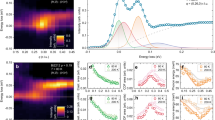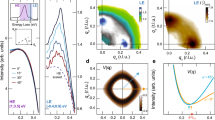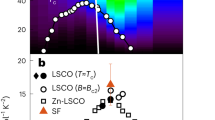Abstract
Copper oxide high-TC superconductors possess a number of exotic orders that coexist with or are proximal to superconductivity. Quantum fluctuations associated with these orders may account for the unusual characteristics of the normal state, and possibly affect the superconductivity1,2,3,4. Yet, spectroscopic evidence for such quantum fluctuations remains elusive. Here, we use resonant inelastic X-ray scattering to reveal spectroscopic evidence of fluctuations associated with a charge order5,6,7,8,9,10,11,12,13,14 in nearly optimally doped Bi2Sr2CaCu2O8+δ. In the superconducting state, while the quasielastic charge order signal decreases with temperature, the interplay between charge order fluctuations and bond-stretching phonons in the form of a Fano-like interference increases, an observation that is incompatible with expectations for competing orders. Invoking general principles, we argue that this behaviour reflects the properties of a dissipative system near an order–disorder quantum critical point, where the dissipation varies with the opening of the pseudogap and superconducting gap at low temperatures, leading to the proliferation of quantum critical fluctuations, which melt charge order.
This is a preview of subscription content, access via your institution
Access options
Access Nature and 54 other Nature Portfolio journals
Get Nature+, our best-value online-access subscription
$29.99 / 30 days
cancel any time
Subscribe to this journal
Receive 12 print issues and online access
$209.00 per year
only $17.42 per issue
Buy this article
- Purchase on Springer Link
- Instant access to full article PDF
Prices may be subject to local taxes which are calculated during checkout




Similar content being viewed by others
Data availability
All other data that support the plots within this paper and other findings of this study are available from the corresponding author upon reasonable request.
Change history
09 October 2020
An amendment to this paper has been published and can be accessed via a link at the top of the paper.
References
Keimer, B. et al. From quantum matter to high-temperature superconductivity in copper. Nature 518, 179–186 (2015).
Varma, C. M. Pseudogap phase and the quantum-critical point in copper-oxide metals. Phys. Rev. Lett. 83, 3538–3541 (1999).
Sachdev, S. Where is the quantum critical point in the cuprate superconductors? Phys. Status Solidi B 247, 537–543 (2010).
Zaanen, J. Why the temperature is high. Nature 430, 512–513 (2004).
Tranquada, J. M., Sternlieb, B. J., Axe, J. D., Nakamura, Y. & Uchida, S. Evidence for stripe correlations of spins and holes in copper oxide superconductors. Nature 375, 561–563 (1995).
Howald, C., Eisaki, H., Kaneko, N. & Kapitulnik, A. Coexistence of periodic modulation of quasiparticle states and superconductivity in Bi2Sr2CaCu2O8+δ. Proc. Natl Acad. Sci. USA 100, 9705–9709 (2003).
Abbamonte, P. et al. Spatially modulated ‘Mottness’ in La2-xBaxCuO4. Nat. Phys. 1, 155–158 (2005).
Ghiringhelli, G. et al. Long-range incommensurate charge fluctuations in (Y,Nd)Ba2Cu3O6+x. Science 337, 821–825 (2012).
Chang, J. et al. Direct observation of competition between superconductivity and charge density wave order in YBa2Cu3O6.67. Nat. Phys. 8, 871–876 (2012).
Comin, R. et al. Charge order driven by fermi-arc instability in Bi2Sr2-xLaxCuO6+δ. Science 343, 390–392 (2014).
da Silva Neto, E. H. et al. Ubiquitous interplay between charge ordering and high-temperature superconductivity in cuprates. Science 343, 393–396 (2014).
Tabis, W. et al. Charge order and its connection with Fermi-liquid charge transport in a pristine high-Tc cuprate. Nat. Commun. 5, 5875 (2014).
Croft, T. P. et al. Charge density wave fluctuations in La2-xSrxCuO4 and their competition with superconductivity. Phys. Rev. B 89, 224513 (2014).
Wen, J.-J. et al. Observation of two types of charge density wave orders in superconducting La2-xSrxCuO4. Nat. Commun. 10, 3269 (2019).
Forgan, F. M. et al. The microscopic structure of charge density wave in underdoped YBa2Cu3O6.54 revealed by X-ray diffraction. Nat. Commun. 6, 10064 (2015).
Chaix, L. et al. Dispersive charge density wave excitations in Bi2Sr2CaCu2O8+δ. Nat. Phys. 13, 952–956 (2017).
Reznik, D. Phonon anomalies and dynamic stripes. Physica C 481, 75–92 (2012).
Pintschovius, L. & Braden, M. Anomalous dispersion of LO phonons in La1.85Sr0.15CuO4. Phys. Rev. B 60, R15039–R15042 (1999).
Park, S. R. et al. Evidence for a charge collective mode associated with superconductivity in copper oxides from neutron and x-ray scattering measurements of La2−xSrxCuO4. Phys. Rev. B 89, 020506(R) (2014).
Devereaux, T. P. et al. Directly characterizing the relative strength and momentum dependence of electron–phonon coupling using resonant inelastic x-ray scattering. Phys. Rev. X 6, 041019 (2016).
Hashimoto, M., Vishik, I. M., He, R. H., Devereaux, T. P. & Shen, Z. X. Energy gaps in high-transition-temperature cuprate superconductors. Nat. Phys. 10, 483–495 (2014).
Allen, P. B. et al. Neutron-scattering profile of Q ≠ 0 phonons in BCS superconductors. Phys. Rev. B 56, 5552–5558 (1997).
Le Tacon, M. et al. Giant phonon anomalies and central peak due to charge density wave formation in YBa2Cu3O6.6. Nat. Phys. 10, 52–58 (2014).
Kim, H. H. et al. Uniaxial pressure control of competing orders in a high-temperature superconductor. Science 362, 1040–1044 (2018).
Sachdev, S. Quantum Phase Transition (Cambridge University Press, 2011).
Vojta, M. Lattice symmetry breaking in cuprate superconductors: stripes, nematics, and superconductivity. Adv. Phys. 58, 699–820 (2009).
Kivelson, S. A. et al. How to detect fluctuating stripes in the high-temperature superconductors. Rev. Mod. Phys. 75, 1201–1241 (2003).
Schmid, A. Diffusion and localization in a dissipative quantum system. Phys. Rev. Lett. 51, 1506–1509 (1983).
Caldeira, A. O. & Leggett, A. J. Quantum tunnelling in a dissipative system. Ann. Phys. 149, 374–456 (1983).
Sperstad, I. B., Stiansen, E. B. & Sudbo, A. Quantum criticality in spin chain with non-Ohmic dissipation. Phys. Rev. B 85, 214302 (2012).
Peng, Y. Y. et al. Re-entrant charge order in overdoped (Bi,Pb)2.12Sr1.88CuO6+δ outside the pseudogap regime. Nat. Mater. 17, 697–702 (2018).
Miao, H. et al. Formation of incommensurate charge density wave in cuprates. Phys. Rev. X 9, 031042 (2019).
Mitrano, M. et al. Ultrafast time-resolved x-ray scattering reveals diffusive charge order dynamics in La2-xBaxCuO4. Sci. Adv. 5, eaax3346 (2019).
Arpaia, R. et al. Dynamical charge density fluctuations pervading the phase diagram of a Cu-based high- superconductor. Science 365, 906–910 (2019).
Minola, M. et al. Collective nature of spin excitations in superconducting cuprates probed by resonant inelastic X-ray scattering. Phys. Rev. Lett. 114, 217003 (2015).
Devereaux, T. P., Virosztek, A. & Zawadowski, A. Charge-transfer fluctuation, d-wave superconductivity, and the B1g Raman phonon in cuprates. Phys. Rev. B 51, 505–514 (1995).
Acknowledgements
This work is supported by the US Department of Energy (DOE), Office of Science, Basic Energy Sciences, Materials Sciences and Engineering Division, under contract DE-AC02-76SF00515. We acknowledge the Diamond Light Source for providing the science commissioning time at the I21 RIXS beamline under Proposal SP18462.
Author information
Authors and Affiliations
Contributions
W.S.L. conceived the experiment. W.S.L., K.-J.Z., M. Hepting, J.L., A.N., A.C.W., M.G.-F. and H.R. conducted the experiment at the Diamond Light Source. J.L., A.N. and K.-J.Z. performed the data processing from the detector. W.S.L., M. Hepting and H.L. analysed the data. W.S.L., B.M., J.Z. and T.P.D. performed the theoretical calculations. K.-J.Z., A.C.W. and M.G.-F. constructed and commissioned the ID21 RIXS beamline and spectrometer at the Diamond Light Source. M. Hashimoto, D.S. and H.E. synthesized and prepared samples for the experiments. W.S.L., Z.X.S., B.M., J.Z. and T.P.D. wrote the manuscript with input from all authors.
Corresponding authors
Ethics declarations
Competing interests
The authors declare no competing interests.
Additional information
Peer review information Nature Physics thanks José Lorenzana and the other, anonymous, reviewer(s) for their contribution to the peer review of this work.
Publisher’s note Springer Nature remains neutral with regard to jurisdictional claims in published maps and institutional affiliations.
Extended data
Extended Data Fig. 1 RIXS experiment and scattering geometry.
a, A representative RIXS spectral taking at Cu L3-edge. In this work, we discuss the inelastic scattering signal below 0.1 eV. The inset shows a typical x-ray absorption curve across the Cu L3-edge, taken by measuring total florescent yield. b, A sketch of the scattering geometry. The crystal axes are denoted as a, b and c. ki and kf represent the incident and scattering photon momentum. 2θ is the scattering angle. The yellow arrow represents the polarization of the incident x-ray. All the data shown in this manuscript were taken using incident beam with sigma polarization.
Extended Data Fig. 2 Raw RIXS spectra and Fitting.
a, An example of the spectra fitting. The fit function consists of a Gaussian function for the elastic peak (blue), an anti-Lorentzian function for the RIXS phonon (red), and a smooth background from high energy (black dashed line). The fit function is convoluted with a Gaussian function with a FWHM corresponding to the energy resolution of the RIXS instrument and fit to the data. b, All Raw RIXS spectra discussed in this work. The red curves are the fits, showing good agreements with the experimental data.
Extended Data Fig. 3 CO excitations continuum used in the model.
a, Intensity map of Im[χλ(q,ω)] with for modeling 15 K data. b, Energy distribution curves at QCO (the vertical black dashed lines in a) with different values of the damping Γ that are used to model the temperature dependence behavior shown in Fig. 4c. c, Momentum distribution curve at 0.06 eV (the horizontal black dashed lines in a), approximately at the bond-stretching phonon energy.
Rights and permissions
About this article
Cite this article
Lee, W.S., Zhou, KJ., Hepting, M. et al. Spectroscopic fingerprint of charge order melting driven by quantum fluctuations in a cuprate. Nat. Phys. 17, 53–57 (2021). https://doi.org/10.1038/s41567-020-0993-7
Received:
Accepted:
Published:
Issue Date:
DOI: https://doi.org/10.1038/s41567-020-0993-7
This article is cited by
-
Signature of quantum criticality in cuprates by charge density fluctuations
Nature Communications (2023)
-
Momentum-resolved spin-conserving two-triplon bound state and continuum in a cuprate ladder
Communications Physics (2023)
-
Critical nematic correlations throughout the superconducting doping range in Bi2−zPbzSr2−yLayCuO6+x
Nature Communications (2023)
-
Unconventional exciton evolution from the pseudogap to superconducting phases in cuprates
Nature Communications (2022)
-
Unveiling the mechanism of non-conventional superconductivity through material genome engineering
Frontiers of Physics (2022)



